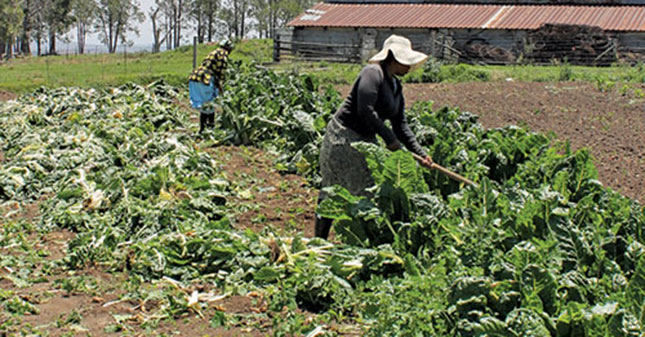
Photo: FW Archive
What is the aim of the Employment Tax Incentive Act?
Before I interpret aspects of this act, I must make it clear that I do so in an advisory capacity only. Farmers should consult their nearest SARS office to find out more. The primary aim is to encourage the private sector to employ young people by using a tax incentive, to meaningfully reduce the cost of giving jobs to youth employees. In some respects, it’s an attempt to make the cake bigger instead of trying to cut it into smaller and smaller pieces.
READ:Success with pigs
How do farmers qualify? What are the most important and relevant requirements?
The employer must be registered with SARS for employees’ tax or PAYE. Without this, there can be no benefits.
Qualifying employees must be between 18 and 29, unless they are employed in an area designated as a ‘special economic zone’ or in an industry designated as exempt by the minister of finance in the Government Gazette. The employee may not be related to the employer, and domestic workers do not qualify.
The employee must have a valid South African identity or asylum seeker’s permit. The qualifying wage is between R2 000 and R6 000 a month. The employee must have started his job on or after 1 October 2013. There is no retrospective application.
What would exclude an employer from the benefits of the scheme?
Disqualifications are automatic if non-qualifying employees are dismissed to take the place of qualifying employees. There is also a R30 000 penalty for this. Employers must adhere to wage regulating measures. Employers not bound by a wage regulating measure would be disqualified if their employees received less than R2 000 a month, but farmers will be disqualified if they pay the employee less than the minimum wage of R2 420,41 a month currently set by sectoral determination 13.
Are there any reasons for a temporary barring from the incentive? If there was an infringement that could be corrected, would the benefit be reinstated?
If the employer has not submitted a tax return or has an outstanding tax debt, the benefit would be temporarily disallowed. But during this time, the benefit can be rolled over until the problem is sorted.
Does the employer qualify for the scheme if he employs seasonal workers?
Yes, seasonal workers are treated in the same way as other employees while employed.
The main thrust of this act is the monetary benefit to the employer. What is the mechanism the employer can access to enjoy the benefit?
At its simplest, the employer is allowed to reduce the total monthly PAYE he would pay to SARS, by the amount gained through the benefit. Every month, the employer pays SARS the employees’ tax, or PAYE, that he has withheld from his employees’ salaries. Where he is entitled to a benefit under the act, he subtracts the value of the benefit from the total PAYE he must pay SARS for his employees. This means that even if qualifying employees are not in the income tax bracket, the employer still gains the benefit by subtracting the amount from the total PAYE paid to SARS.
If the money owed to the employer is more than the total PAYE, the excess can be rolled over to the next month, and again to the following month and so on. When the employer submits his tax return every six months, he can submit a claim to SARS for the excess not covered by the total employees’ tax and all the excess amounts rolled over from the previous five months.
The provision, which will allow the employer to claim in this way, has no legal force yet. Until it is published in the Government Gazette, the excess must be rolled over to the next six-month period.
The tax benefit is calculated at 50% of the monthly wage if the employee earns R2 000. If the employee earns between R2 001 and R4 001, the benefit is fixed at R1 000 a month. If the employee earns between R4 001 and R6 000, the benefit is calculated as R1 000 – ½ (monthly wages – R4 000). So if the wages were R5 000, the benefit would be R500. At R6 000, the benefit would be zero. In the second year, the benefit would be 25% of the monthly wage at R2 000, and R500 for employees earning between R2 001 and R4 001. For employees earning between R4 001 and R6 000, it is calculated as R500 – ¼ (monthly wages – R4 000).
Is there a cap on the ‘excess’ an employer can claim?
Yes, once the reimburse-ment scheme is in operation, an employer can claim a maximum of R6 000 for every qualifying employee employed when he does his reconciliation. The amount would be capped at R6 000 multiplied by the number of qualifying employees employed for the six months. Failing the announcement of the scheme, the excess must be carried over into the next six-month reconciliation period.
Can you describe in more detail how the roll over works?
For example, if a farmer were entitled to a benefit of R1 000 and his total PAYE bill were R500, he could receive only R500 as a portion of his benefit. He would be left with R500 owed to him. This excess he would roll over until the next month and finally claim it at the end of the six months. At the end of this period, he would be entitled to the unpaid portion of the benefit (R3 000 in this example). If the reimbursement scheme has not been proclaimed, the R3 000 excess must be rolled over to the next six months.
How would it work if employees were not in the PAYE bracket but all qualified for the tax incentive?
The farmer must still be registered for PAYE tax. The PAYE would be zero but the benefit owed to the employer (R1 000 per qualifying employee per month) must be treated as an excess and carried over to the next month until the six months has passed. Once again, if the minister has not opened the reimbursement scheme, the amount can be rolled over into the next six months.
How long does this tax incentive stay in operation?
The benefits apply for two years only on the sliding scale mentioned above. The incentive applies only to qualifying employees who began work on or after 1 October 2013 and no benefits can be claimed unless work commenced on or after this date.
Are there any other conditions farmers should know about?
An employee would not qualify if, say, he or she had been employed before the specific date and was then deployed to another farm that was part of the same business or belonged to a close relative. If the employee qualified, the calculations would be done in the normal way and migration within a business or family would make no difference.
Do you see real advantages to this act and its tax incentive or do you think its power is limited?
I welcome anything that supports the creation of additional jobs and I think there is potential here to do that. Of course, there are problems in the sector that may make employers and employees wary, but properly used, there can be real advantages.
The administration required is not at all onerous, so farmers need not fear more burdensome clerical work.
Phone Theo Boshoff on 012 643 3444 or email [email protected].
This article was originally published in the 4 April 2014 issue of Farmer’s Weekly.













